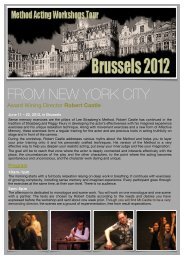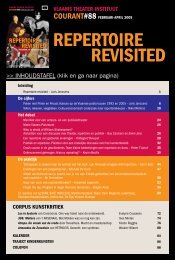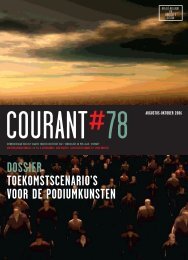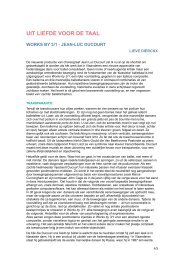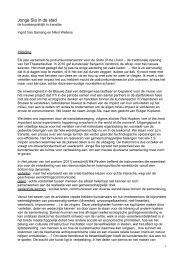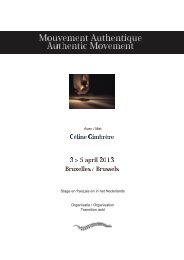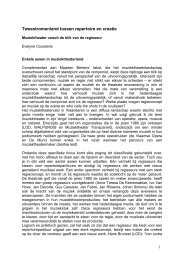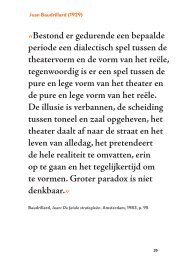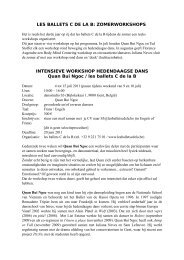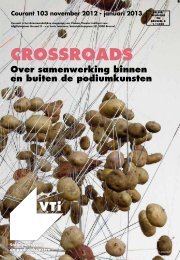music theatre in flanders - Muziekcentrum Vlaanderen
music theatre in flanders - Muziekcentrum Vlaanderen
music theatre in flanders - Muziekcentrum Vlaanderen
You also want an ePaper? Increase the reach of your titles
YUMPU automatically turns print PDFs into web optimized ePapers that Google loves.
Diagram 10: A closer look at the Perform<strong>in</strong>g Arts Decree<br />
200<br />
150<br />
100<br />
50<br />
0<br />
45<br />
<strong>music</strong> <strong>theatre</strong> structure<br />
project subsidies organisation<br />
<strong>theatre</strong> structure<br />
arts centre<br />
dance structure<br />
festival<br />
55<br />
13<br />
30<br />
32<br />
0<br />
83<br />
63<br />
13<br />
1993-1997 1997-2001 2001-2005<br />
How does the growth of <strong>music</strong> <strong>theatre</strong> production relate to the<br />
Perform<strong>in</strong>g Arts Decree sub-categories? It is strik<strong>in</strong>g that for each<br />
subsidy term, it is other organizations that account for the growth.<br />
The growth for the period 1997-2001 can ma<strong>in</strong>ly be attributed<br />
to <strong>music</strong> <strong>theatre</strong> structures and arts centres. Dur<strong>in</strong>g this period,<br />
the number of credits <strong>in</strong> these two categories doubles: from 45<br />
to 83 for the <strong>music</strong> <strong>theatre</strong> structures, and from 32 to 66 for the<br />
arts centres.<br />
This tendency, however, is not cont<strong>in</strong>ued dur<strong>in</strong>g the period<br />
2001-2005. The arts centres’ share comes to a standstill. The <strong>music</strong><br />
<strong>theatre</strong>s’ share, nevertheless, goes on grow<strong>in</strong>g, but at a slower<br />
pace. On the other hand, different organizations emerge strongly:<br />
the <strong>theatre</strong> and dance structures. Compared to the period 1993-<br />
1997, <strong>music</strong> <strong>theatre</strong> production, or the use of on stage live <strong>music</strong>,<br />
by <strong>theatre</strong> and dance companies rema<strong>in</strong>ed stable dur<strong>in</strong>g the pe-<br />
40<br />
66<br />
0<br />
103<br />
169<br />
41<br />
63<br />
65<br />
18<br />
riod 1997-2001. But then, dur<strong>in</strong>g the period 2001-2005 this type<br />
of production nearly triples among <strong>theatre</strong> structures, and more<br />
than triples among dance structures.<br />
COnCluSIOn: MuSIC TheATre’S blurrInG bOundArIeS<br />
In the global Flemish perform<strong>in</strong>g arts production, we marked out<br />
a ‘<strong>music</strong> <strong>theatre</strong>’ segment on the basis of genre labels and <strong>in</strong>formation<br />
about the cast. In some important respects, this segment’s<br />
evolution differs from the rest of the perform<strong>in</strong>g arts. The<br />
growth of Flemish perform<strong>in</strong>g arts production between 1993 and<br />
2005 comes to a standstill after 2000, but <strong>music</strong> <strong>theatre</strong> keeps on<br />
grow<strong>in</strong>g considerably.<br />
How can this <strong>in</strong>creas<strong>in</strong>g growth of <strong>music</strong> <strong>theatre</strong> be expla<strong>in</strong>ed?<br />
There are several reasons. The emergence of co-production practice<br />
<strong>in</strong> an ever more <strong>in</strong>ternational environment dur<strong>in</strong>g the exam<strong>in</strong>ed<br />
period is one of them. The diagrams reveal that there is a lot<br />
more co-production <strong>in</strong> <strong>music</strong> <strong>theatre</strong> than <strong>in</strong> any other perform<strong>in</strong>g<br />
arts discipl<strong>in</strong>e. They also reveal that this co-production takes<br />
place <strong>in</strong> a network that is more <strong>in</strong>ternational than for the other<br />
discipl<strong>in</strong>es. A lot of <strong>music</strong> <strong>theatre</strong> structures operate on an <strong>in</strong>ternational<br />
scale. Furthermore, there are quite some <strong>in</strong>ternationally<br />
oriented <strong>theatre</strong> and dance companies that often work with on<br />
stage live <strong>music</strong>.<br />
Internationalization is certa<strong>in</strong>ly not the only explanation for<br />
the growth of the <strong>music</strong> <strong>theatre</strong> segment. 1993 was the year when<br />
the 1975 Theatre Decree was replaced by the Perform<strong>in</strong>g Arts<br />
Decree, which would spark off a strong dynamism. From then on,<br />
dance and <strong>music</strong> <strong>theatre</strong> companies could also receive structural<br />
recognition and f<strong>in</strong>ancial support. The period 1993-1997 saw the<br />
emergence of a number of <strong>music</strong> <strong>theatre</strong> companies, some of<br />
which are still active today. And these organizations went through<br />
36 37<br />
table of contents




